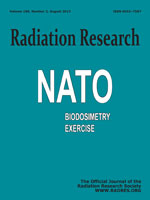Astronauts have the potential to develop the hematopoietic syndrome as a result of exposure to radiation from a solar particle event (SPE) during exploration class missions. This syndrome is characterized by a reduction in the number of circulating blood cells (cytopenias). In the present study the effects of SPE-like proton and γ radiation on the kinetics of circulating neutrophils were evaluated during a one-month time period using mice as a model system. The results revealed that exposure to a 2 Gy dose of either SPE-like proton or γ radiation significantly decreased the number of circulating neutrophils, with two nadirs observed on day 4 and day 16 postirradiation. Low circulating neutrophil count (neutropenia) is particularly important because it can increase the risk of astronauts developing infections, which can compromise the success of the mission. Thus, two granulocyte colony-stimulating factors (G-CSFs), filgrastim and pegfilgrastim were evaluated as countermeasures for this endpoint. Both forms of G-CSF significantly increased neutrophil counts in irradiated mice, however, the effect of pegfilgrastim was more potent and lasted longer than filgrastim. Using the expression of CD11b, CD18 and the production of reactive oxygen species (ROS) as markers of neutrophil activation, it was determined that the neutrophils in the irradiated mice treated with pegfilgrastim were physiologically active. Thus, these results suggest that pegfilgrastim could be a potential countermeasure for the reduced number of circulating neutrophils in irradiated animals.
How to translate text using browser tools
5 July 2013
Kinetics of Neutrophils in Mice Exposed to Radiation and/or Granulocyte Colony-Stimulating Factor Treatment
A. L. Romero-Weaver,
X. S. Wan,
E. S. Diffenderfer,
L. Lin,
A. R. Kennedy
ACCESS THE FULL ARTICLE

Radiation Research
Vol. 180 • No. 2
August 2013
Vol. 180 • No. 2
August 2013




